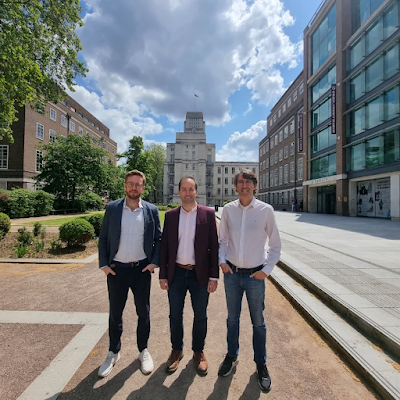A warm welcome to Oxford Cryotechnology, using computational methods for cryopreservation, and good luck to the founders!
Oxford Cryotechnology is the new company founded by our spokesperson, Dr Roman Bauer, together with Prof. Joao Pedro de Magalhaes (University of Birmingham) and Dr Emil Kendziorra (Tomorrow Biostasis), to bridge the gap between research and practice gold standards in cryopreservation of cells, tissues and organs.

The team behind Oxford Cryotech. From left to right: Dr Emil Kendziorra, Dr Roman Bauer, and Prof. Joao Pedro de Magalhaes.
Oxford Cryotechnology will take advantage of a wide range of computational methods and in-silico modelling strategies building on recent work that resulted in CryoDynaMo [1] (supported by EPSRC grant #EP/S001433/1), an extension of BioDynaMo that demonstrated the viability of agent-based modelling of cryopreservation protocols.
The new company will be heavily invested in continuing R&I in the field (see also [2]), and this will open to new opportunities of iteratively improving CryoDynaMo against data from new experimental setups.
We at BioDynaMo are especially excited: Oxford Cryotechnology, by exploiting computational tools to accelerate progress in cryopreservation practice and research, will mark a change of pace in how BioDynaMo impacts the life science ecosystems… and not least because this activity can be expected to feed new growth opportunities and intuitions to the project.
We wish Dr Bauer and his collaborators all the best in this promising endeavour that could translate into impact in biomedicine at large, from transplant practices, all the way to interstellar travels!
- Jennings, J., Bojic, S., Sharpe, A. and Bauer, R., 2021. Simulating The Thermodynamic Processes of Cryopreservation Utilising The Cryodynamo Cryopreservation Modelling Package. Cryobiology, 103, p.171.
- Bojic, S., Murray, A., Bentley, B.L., Spindler, R., Pawlik, P., Cordeiro, J.L., Bauer, R. and De Magalhães, J.P., 2021. Winter is coming: the future of cryopreservation. BMC biology, 19(1), pp.1-20.



Comments
Post a Comment